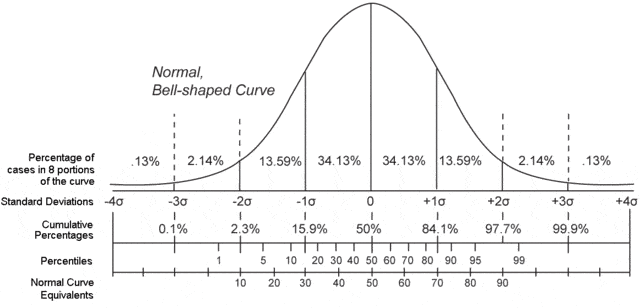IQ stands for Intelligence Quotient and is meant to be a measure of your intelligence which is expressed as a number.
Essentially, you take a test that is designed to measure your IQ. This test will then gauge your Intelligence Quotient by providing an estimate of your intelligence, expressed as a number.
We touch more on what exactly IQ is in the section below.
There are many misconceptions about IQ and its meaning. We will clear things up in regard to IQ and is meaning. We will answer the following questions:
- What Does IQ Stand For?
- What Does IQ Mean?
- What Is IQ?
Summary: IQ stands for Intelligence Quotient and is used to measure your intelligence.
If you want to find your IQ, take our free IQ test.
What Does IQ Mean?
The exact definition of intelligence debatable. However, the generally accepted definition of intelligence is:
- Intelligence is one’s ability to gain knowledge and, one’s ability to use this knowledge to problem-solve or to meet an objective.
To simplify, IQ means how smart or clever an individual is, based on an accepted test or evaluation taken by that individual.
The problem with intelligence is that it is an abstract concept. As social scientists, psychologists, and medical personnel began trying to quantify intelligence, they soon realized that it would be difficult.
Despite the remarkable challenge they faced, they continued to design ways in which to measure an individual’s intelligence – objectively, and accurately.
In 1912, the psychologist William Stern created the term IQ. The catchphrase Intelligence Quotient (IQ) is derived from the German concept known as intelligenzquotient – a scoring method developed and used by William Stern when he was a professor.
More than 100 years later, the concept of the Intelligence Quotient remains an ongoing debate. You can read this IQ research study for additional information.
What is IQ?
An Intelligence Quotient is a mathematical measurement that is calculated from the results of an IQ test. The IQ score is a measurement of your intelligence, expressed as a number.
However, it is important to note that an IQ score is based on data derived from abstract concepts, so an IQ score can only represent an estimate of one’s intelligence.
Your final IQ score is the calculation of how you performed on the IQ test in terms of problem-solving and logical reasoning. You can learn more about IQ score ranges with our complete guide.
IQ is a Mathematical Concept
By itself, an IQ score has no real meaning. It’s meaning is only created when used as a comparative tool against a sample population.
Your IQ score is a statistical placement based on where your score falls in direct relation to the scores generated by other test takers.
IQ scoring uses a standard bell curve to denote where a test-taker’s results fall in relation to others. Use the figure below to get a better idea of what a bell-shaped curve accomplishes.
The bell-shaped curve above visually represents what is known as a normal distribution. The vertical axis contains the number of people who have earned a particular score. The horizontal axis is the defined distribution of all the possible IQ score results.
What are IQ Tests Used For?
IQ evaluations are used across many different industries to evaluate potential students and employees across a number of disciplines.
An IQ test can be used in the following instances:
- Diagnose poor school performance for children
- Diagnosing intellectual disabilities in individuals
- Class/course placement in school
- Job interviews
While these are just a few instances in which an IQ test can be used, they are the more common applications.
IQ Tests Currently in Use
While there are a variety of Intelligent Quotient examinations given to today’s test-takers, the most commonplace IQ tests include:
- The Stanford-Binet Intelligence Scales.
- The Wechsler Adult Intelligence Scale (WAIS).
The Stanford-Binet Intelligence Scale
The Stanford-Binet Intelligence Scale IQ test is most widely known as it is used to assess intelligence in young adults and children throughout the public school system.
Although, the administrators noted that this exam could be taken by anyone aged 2 through 85.
The Stanford-Binet Intelligence Scale was first developed in France more than 100 years ago by Alfred Binet, a psychologist working in concert with the French government to evaluate each child’s intelligence, so each child receives the educational support that is needed.
At that time, it was known as the Binet-Simon Scale, as Binet’s student Theodore Simon and he were partners in developing the finalized version of the intelligence scale.
When the Binet-Simon scale (and its associated test) was translated to English, the United States public school systems began testing children to gauge a student’s intellectual abilities, and the psychiatric community began using it as a diagnostic tool to identify mental health issues.
In fact, the US military, during WWI, tested each new cadet.
Several years later, the educational psychologist Lewis Terman modified the original Binet-Simon Scale as a Stanford University professor studying the genius in gifted individuals, especially children.
By 1916, the newly named Stanford-Binet Intelligence Scale was officially adopted as the United States’ standard IQ test.
IQ tests, like the Stanford-Binet Intelligence Scales or the Wechsler Adult Intelligence Scale (WAIS-IV), are made up of at least one hundred questions and can take an hour or more to complete.
The Reliability of the Stanford-Binet IQ Exam
The Stanford-Binet IQ examination has undergone a litany of revisions but has been successfully validated by several scientifically-backed studies over the past century or so.
The reality is that human intelligence is unreasonably difficult to measure, so each IQ test version bumps up against issues that need addressing.
However, after one hundred years in use, the Stanford-Binet test generates results that are deemed accurate by the educational community and other industries.
The Wechsler Adult Intelligence Scale (WAIS)
The American psychologist, David Wechsler, created the Wechsler Adult Intelligence Scale (WAIS) in the mid-1950s. It is noted, however, that the precursor to the now widely used Wechsler Adult intelligence Scale (WAIS – IV) was called the Wechsler-Bellevue Intelligence Scale (WBIS).
The WAIS’ response to the WAIS was overwhelming and by the 1960s, the WAIS IQ test held the distinction as being the most popular IQ test in use. The latest version of the Wechsler Adult Intelligence Scale is known as WAIS-IV.
The fundamental difference between the Stanford-Binet and the WAIS is that the WAIS seeks to assess the intelligence of adults, where the Stanford-Binet was designed for testing children and young adults.
David Wechsler was interested in evaluating a test-taker’s knowledge acquisition capabilities, their intelligence, and comprehensive understanding because it was his belief that a person’s intelligence was comprised of interrelated components that could be, if isolated, accurately measured.
Wechsler also recognized that the Stanford-Binet test was geared towards children and not adults.
The WAIS is the most often administered to young adults (i.e. teenagers) and adults between the ages of 16 and 90.
Note: IQ tests are substantially different than personality tests.
IQ Meaning Takeaway
IQ stands for Intelligence Quotient. This is a numbered score you receive after taking an accepted IQ evaluation. Testing and educational scientists have shown the IQ test to be a solid predictor of a test takers’
- Performance at work
- Health
- Inclination towards a criminal lifestyle
- Life expectancy
- Socio-economic placement in society
The IQ is imperfect because it is man-made, but overall it helps determine many important issues related to life’s goals, expectations, and objectives.


